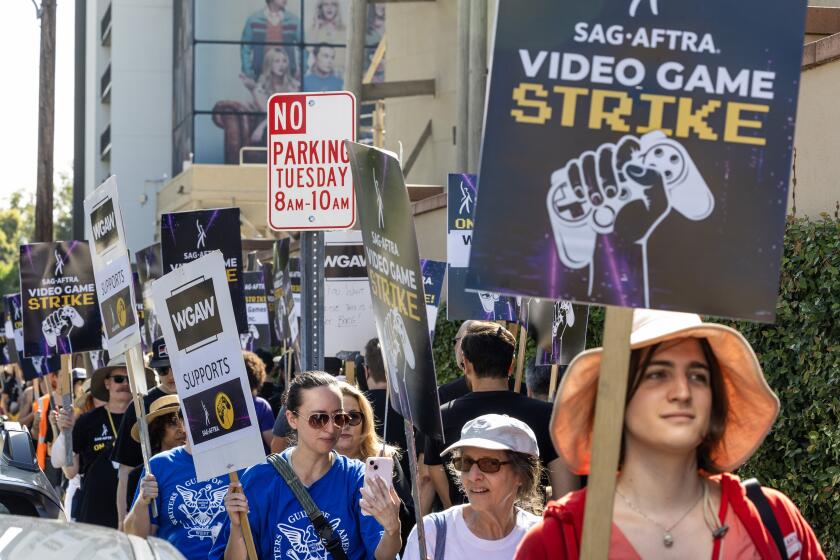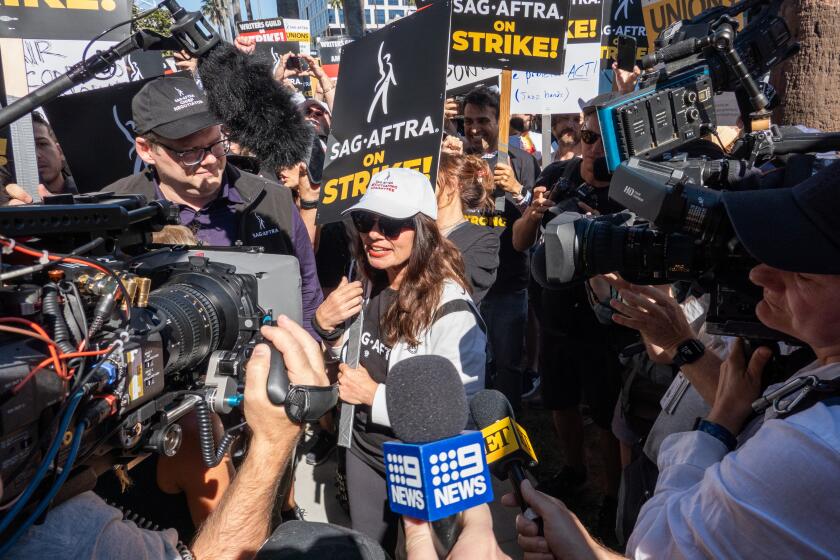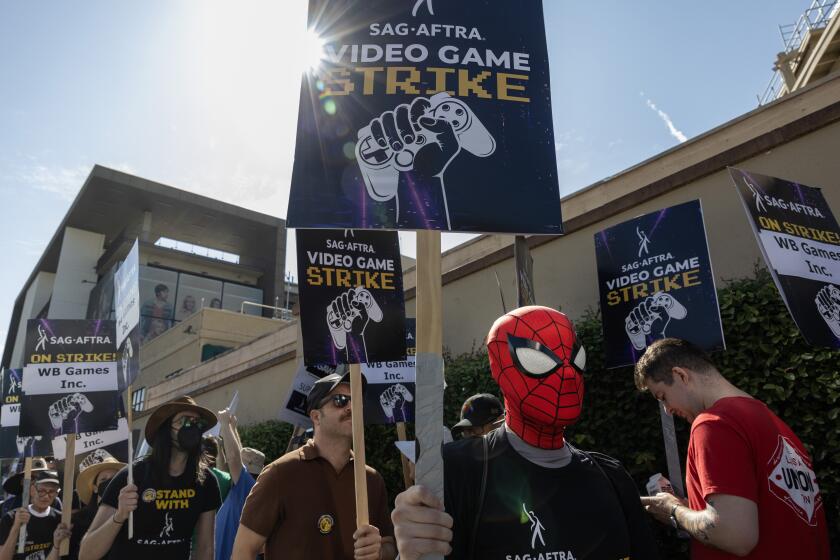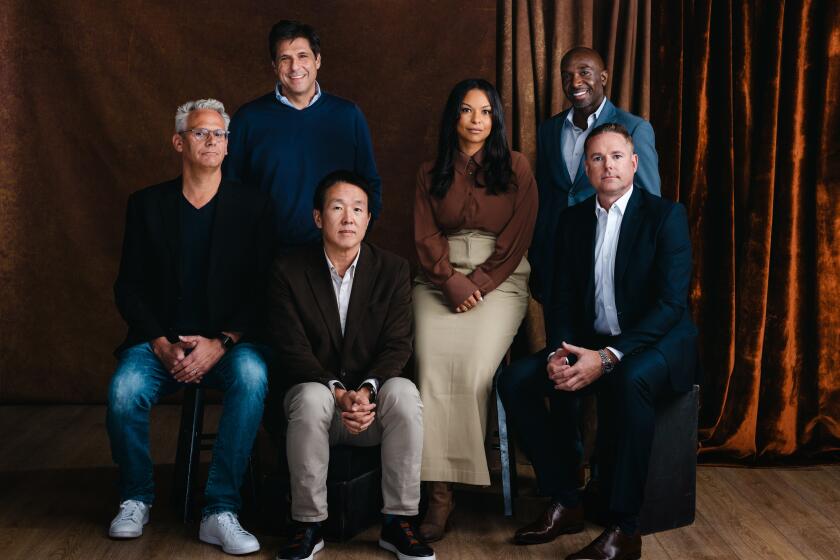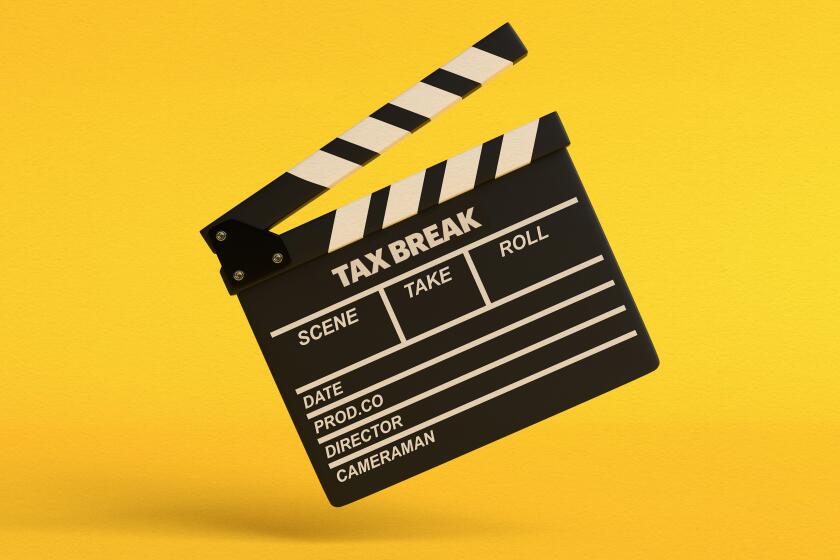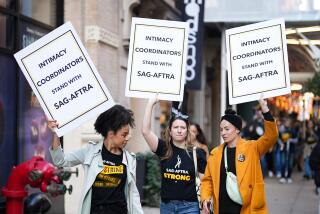Hollywood unions are facing an uphill battle against Trump, AI and the slowdown

- Share via
- More than a year after strikes by actors and writers, lower profile workers are pressing their own demands for a better deal amid concerns about AI, outsourcing and media consolidation.
- But it remains to be seen whether major media and entertainment companies will be sympathetic as they face higher costs and adapt to a Trump administration that may not be as friendly to union demands.
Video game performers. Visual effects artists. Animation workers. Intimacy coordinators.
More than a year after overlapping strikes by Hollywood writers and actors that rattled the entertainment industry, many technicians and craftspeople who operate outside of the spotlight are pressing their own demands for a better deal.
The sustained unrest among entertainment workers has added to the volatility that has gripped a film and TV business still recovering from the pandemic, prior labor disruptions and a persistent industry contraction.
The labor discord has been fueled by several forces, including the rising cost of living in Southern California, the outsourcing of jobs to other states and countries and the spread of artificial intelligence technology that many see as a threat to jobs.
SAG-AFTRA and the video game companies are resuming contract negotiations for the first time since video game actors went on strike.
It’s unclear, however, how the major media and entertainment companies will respond to the demands. Studios and other firms are under intense pressure to cut costs in an uncertain market that’s undergoing rapid change. And the election of Donald Trump, whose administration is expected to be generally pro-business, could give media executives latitude to take a harder line in bargaining.
“Clearly there’s going to be less protections for workers and less regulatory oversight for business practices going forward,” said David Smith, professor of economics at the Pepperdine Graziadio Business School. “When that goes into effect and whether that is a priority for the new Trump administration are open questions.”
Driving much of the labor tensions is the fear of AI, which many studio executives see as a necessary way to save money and stay ahead technologically.
AI is the biggest issue in the ongoing standoff between video game companies and performers covered by SAG-AFTRA, who’ve been on strike since July.
Video game actors are on strike after performers union SAG-AFTRA and the video game companies couldn’t agree on AI terms.
SAG-AFTRA is seeking a contract that will require game developers to obtain informed consent and compensate video game performers when using the technology to digitally replicate their voices, movements or likenesses.
The game companies have said that their AI proposal already contains robust protections that would require employers to seek prior consent and pay actors fairly when cloning their performances.
But the union maintains that the proposed language is not strong enough to protect on-camera performers, whose job is often to disappear into the characters they bring to life.
SAG-AFTRA says 80 video games have agreed to abide by its proposed AI terms amid the ongoing video game actors’ strike.
“We have worked hard to deliver proposals with reasonable terms that protect the rights of performers while ensuring we can continue to use the most advanced technology to create great entertainment experiences for fans,” said Audrey Cooling, a spokesperson for the game companies, in a statement earlier this year.
The union and the game developers most recently convened in late October for a few bargaining sessions, but the walkout continues.
“All performers need AI protections,” said Duncan Crabtree-Ireland, national executive director and chief negotiator of the Screen Actors Guild-American Federation of Television and Radio Artists. “Everyone’s at risk, and it’s not OK to carve out a set of performers and leave them out of AI protections.”
All unions representing entertainment workers — including actors, writers, directors and crew members — have sought AI regulations in their latest contracts in an effort to shield their members from job displacement before it’s too late.
“All of these new applications for the creative content have changed the way that we value labor and the people involved,” said Sarah Odenkirk, an attorney for artists and a lecturer at USC. “The unions’ jobs are to protect their members, and that becomes a complicated process when you’re talking about fundamental changes in technology and the delivery systems for content.”
The Times spoke to Nicole Brown of TriStar Pictures; Sam Register of Warner Bros. Animation; Jonathan Glickman of Panoramic Media Co.; Roy Lee of Vertigo Entertainment; FredAnthony Smith of SMAC Entertainment and Chris Hart of United Talent Agency
Disputes over AI protections have also fueled tensions in Hollywood’s close-knit animation community. The issue remains a top priority of the Animation Guild, which announced it had reached a tentatative new contract with the Alliance of Motion Picture and Television Producers on Monday after more than three months of bargaining. The proposed deal features wage increases and AI protections.
The union’s current contract, which originally expired July 31, was extended to Dec. 2.
Animation has powered some of the biggest box office hits of the last few years. But animators are widely seen as especially vulnerable to AI. In recent petitions to studios, animation workers have described the technology as an existential threat.
“The work that entertainment workers generate is so available for machine learning to steal,” said Allison Smartt, a field organizer at the animation guild. “Think about how that would make you feel.”
California has a film and TV production problem. Industry professionals and experts are trying to determine what can be done to fix it.
Visual effects workers, who play a pivotal role in bringing movies and TV shows to life, have also been clamoring for change.
Over the last few years, VFX artists have been unionizing under IATSE at a rapid pace. Staffers at companies such as Disney and Marvel have taken steps to secure their first contracts.
Scott Ross, who ran Industrial Light & Magic in the 1980s and was a founder of Digital Domain, says what’s motivating modern VFX workers to unionize is the sense that they’re “not given their due” by much of Hollywood.
“I’ve said it for years, and I’ll say it again: The new movie stars are the visual effects in the movie,” Ross said. “That’s what puts people’s butts in the seats. That’s what the marketing is about.”
Intimacy coordinators have voted to unionize under SAG-AFTRA. They are the professionals who help actors prepare for and stage sensitive scenes.
The latest group to unionize are intimacy coordinators, a new category of workers who guide actors through sensitive material on sets. They voted unanimously in favor of joining SAG-AFTRA this month.
Erin Tillman, a sex educator and intimacy coordinator who has worked on “Yellowstone” and “Days of Our Lives,” said that intimacy coordinators and production assistants are often the only nonunion workers employed on union sets.
“Why shouldn’t we get the same thing that all these other positions get when we’re literally taking care of the safety and well-being of performers at their most vulnerable?” Tillman said. “We just want to feel the same level of safety and be compensated in a way that feels in alignment with other crew positions on sets.”
The labor disquiet has been further fueled by a bleak jobs market.
California, where much of the unionized entertainment workforce resides, has been hit particularly hard, and many professionals have been out of work for more than a year.
At the same time, entertainment companies have been increasingly outsourcing production — flocking to the United Kingdom, Central Europe and other international destinations in pursuit of generous tax incentives. California Gov. Gavin Newsom recently proposed a significant boost in state tax credits to address the problem.
Last month, outgoing Sony Pictures CEO Tony Vinciquerra partially blamed new labor contract terms and higher below-the-line wages for “forcing productions out” of the United States at Mipcom, a TV industry convention held in Cannes, France. The effect of the strikes has been “far more severe ... than anyone understands,” Vinciquerra said at the event.
“We tried to convince [the unions], we tried to talk to the unions about what ... we thought would happen, and now it is happening,” he said. Other entertainment industry leaders have privately expressed similar frustrations.
But Crabtree-Ireland rebuked Vinciquerra’s remarks as “a cynical attempt to manipulate workers while masking the industry’s own business failures.” He told The Times that several executives at rival studios reached out to tell him they disagreed with Vinciquerra’s comments.
At a recent programming presentation in West Hollywood, HBO Chief Executive Casey Bloys said that contract terms are not “fundamentally going to change how we approach making shows.” He acknowledged, however, that production costs and tax incentives are always a factor when deciding whether to shoot a project in “Atlanta versus L.A. versus Canada.”
Times staff writer Meg James contributed to this report.
More to Read
Inside the business of entertainment
The Wide Shot brings you news, analysis and insights on everything from streaming wars to production — and what it all means for the future.
You may occasionally receive promotional content from the Los Angeles Times.
